
History proves that the perceived and alleged conflict between use of the terms “Merry Christmas” and “Happy Holidays” as one of religious observance and commercial secularism is specious. (carlanthonyonline.com)

The Blue versus the Red has even been incorporated into children’s toys.
Republican and Democratic. Summer and Winter. Science and Religion. Men and Women. Happy Holidays and Merry Christmas.
Like so much of the national dialogue, even this festive period of the calendar has been reduced to a winner-take-all Team Red versus Team Blue game, where it is suggested that the sole purpose of one way of thinking and living is to destroy the other one. As if one way would be better off existing in a vacuum without even the suggestion of the other. As if one had not emerged partially in response to the existence of the other.

Television personality Bill O’Reilly is often credited with first making the claim of a “War on Christmas.”
As if one was being contradictory by wishing people both “Merry Christmas” and “Happy Holidays,” rather than one or the other.
A so-called “war on Christmas” was mounted in the media on the premise that the growing use of the expression “Happy Holidays” was proof that a menacing secularism was seeping into the national consciousness and poisoning the perception of December twenty-fifth as the day that Jesus Christ was born some 2022 years ago this Friday.
All of the assiduously detailed facts below about the origins of Christmas and the season of happy holidays may well induce a faster headache in this season than a triple-shot Egg Nog.

The menorah, one symbol of one holiday occurring between late November and late December.
One can skip all below, and simply remember that between the fourth Thursday in November and the first day of January, there are two civic celebrations (Thanksgiving and New Year’s Day), an eight-day religious festival of lights (Hanukkah), two days of cultural tradition (Boxing Day, Kwanza), a holy day (Christmas), and two days with two nights before one holy day and one civic celebration (Christmas Eve and New Year’s Eve).
That’s fifteen days marked by gatherings of family and friends in the darkest time of the year, lots of eating and drinking together, and much exchanging of gifts. It is not one holiday but a plurality and it is traditionally a time of happy celebration.
Or, in short hand, the happy holidays.
For those, however, who prefer their happy holidays full of disagreeable debate, a look back a millennium may offer some bickering points.
Keeping the Saturn in Saturnalia

If Christ’s day of birth was not yet cause for parties, drinking and gift-giving in the first few centuries after the event, the pagan Roman festival of Saturnalia still was and for awhile both events were concurrently recognized.

An early Saturnalia celebration.
Saturnalia, pre-dating Christ’s birth by several centuries, was notable for its use of candles, intended to light the darkest time of the year.
Held in honor of the Roman god Saturn, the holiday began on December seventeenth and initially it ran until December twenty-first, although in the latter years of the Roman Empire it was extended to a season of seven contiguous holy days.
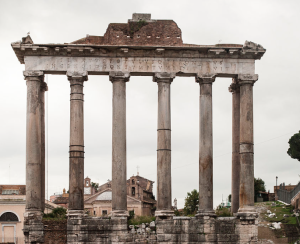
The temple of Saturn.
On the first day of Saturnalia, December the seventeenth, there was a religious ceremony at the temple of Saturn. All trades, academies and courts were closed in observance of the solemn sacrifices taking place on this day. At night, after the religious services, there were public
On the second day, December the eighteenth, families gathered to maintain customs of the season, including the sacrifice of a suckling pig.
In light of those who criticize the commercialization of Christmas as fixating people’s attention on the marketing and buying of gifts, the third day of Saturnalia is especially relevant.
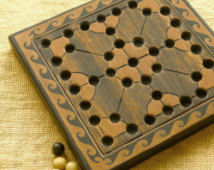
Board games crafted from woods were among the gifts given kids on the second day of Saturnalia morning.
The fact is that even 2,000 years ago in a time with no Internet to click or department store to meander, the act of giving and receiving gifts was a central element to this particular holiday.
The Sigillaria, as the day was known, was set aside for the exchange of presents. Kids got toys. Moms got perfume. Dads got pipes. And in an age when Apple meant a red, round fruit, “tablets” were popular gifts.
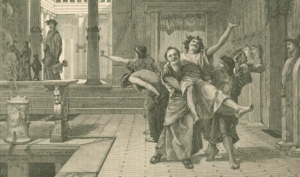
A Roman having to be carried home after a happy holiday party.
Other aspects of this holiday season included special treatment of the poor. Small monetary gift bags filled with coins were given to servants. Slaves were invited to dine formally like their masters, some accounts claiming that they either dined together or that the latter served the former.
While there is no record of Bourbon Eggnog or Rum Cider being served, Saturnalia was also marked by parties of heavy drinking, as well as gambling.
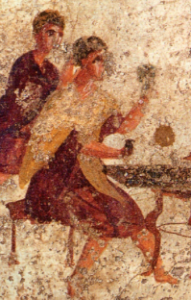
Roman holiday: a man playing dice in what has been identified as a fur hat.
Instead of their everyday toga, Romans donned fancy clothes “of color” just for the holiday season. One Roman gent was even depicted in the Calendar of Philocalus as wearing a fur-trimmed coat.
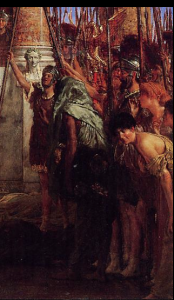
Romans shout the season’s greetings of “Yo Saturnalia!”
As Romans went about, always heard in the streets was the merry greeting of the season, “Yo Saturnalia!”
It was such a good time that, over the centuries, the central religious point of it all, to reverently honor the god Saturn on his holy day, expanded into a full week of happy holy days.
How this holiday season of contiguous evolved by the later Roman Empire era suggests a significant connection to modern concepts of Christmas Day.
Happy Birthday?

Trying to prove that December twenty-fifth is, in fact, the “birthday” of Christ is itself an argument. After all, no birth certificate was ever produced, nothing survives in the way of census records.

A depiction of the birth of Jesus Christ.
Those who do not believe that Christ was the son of God can not deny a solid historical record that proves He was, in fact, born and existed.
Those who do, however, can not deny that no evidence proves that he was born on December twenty-fifth.
The first claims of this date as Christ’s date of birth emerge about 150 years after the fact, premised on a curious claim: Christ was born, so early church leaders insisted, exactly nine months to the day he was conceived, which is stated as being March twenty-fifth. His date of conception is emphatically claimed to be known because it was the same day he was crucified.

A depiction of Christ’s crucification.
There are non-religious texts which corroborate rather precisely the date of Christ’s crucifixion but the logic that uses this as the same day as conception relies on “a traditional Jewish belief that great men lived a whole number of years, without fractions.” Based on the earliest and most authentic documentation, and interpreted by the most scholarly expertise, Christ’s real birthday is, ultimately, theoretical.
In fact, there isn’t even evidence to state what year the early Christian church first decided to designate December twenty-fifth as the religious observance of Christ’s earthly birth. The earliest known record stating that the day was a liturgical feast to commemorate Christ’s birth is in the “Chronogrophy of 354,” made for a wealthy Roman as a calendar book of important dates.
The Sun, A God?


An ancient mosaic blended the figures of Christ and the sun god to create “Christ the Sun.”
In the old Roman calendar, December twenty-fifth (not the twenty-first) was the darkest day, that of the winter solstice, but marked with the knowledge that it also signaled the slow return of light.
The Sun was worshipped as the almighty of all the gods, encompassing them all and, with a temple to honor the sun being dedicated on December twenty-fifth in the year 274, the day was designated as Dies Natalis Solis Invicti, or “birthday of the Unconquerable Sun.”
Despite the steady rise of Christianity as a religion and political power that eventually came to rule the Roman Empire during the 300s, pagan culture persisted in the collective memory. The newly converted Christians were eager to drop the religious ceremonies at the Temple of Saturn, but not the fun of those old happy holy days of Saturnalia.

Even after becoming Christians, Romans celebrated Saturnalia.
Yes, those fallen pagans kept on crafting and shopping obsessively for gifts, and naughtily took the “Saturn out of Saturnalia.”
There is no consistent or definitive chronology of when December twenty-fifth suddenly becoming a genuine Christian holiday.
On the one hand, a North African branch of early Christianity evidenced the celebration of Christ’s birth as early as 311, while in the Eastern Christian church it was January sixth that was used to mark the birth of Christ until about 388.

The early Christian Christmas seemed to blend well with the old Saturnalia.
Scripture scholars also contended that only vain sinners celebrated birthdays and that God was always present, thus never born on a specific date.
Contradicting this was the argument that December twenty-fifth should be celebrated because it marked the birth of Christ the human, not the deity.
A scribbling on a 12th century Syrian bishop’s manuscript suggests a sort of if-you-can’t-beat-them-join-them tactic:
“It was a custom of the Pagans to celebrate on the same 25 December the birthday of the Sun, at which they kindled lights in token of festivity. In these solemnities and revelries the Christians also took part. Accordingly when the doctors of the Church perceived that the Christians had a leaning to this festival, they took counsel and resolved that the true Nativity should be solemnised on that day.”
Justification for combining these two events was biblically predicated on Malachi 4:2, reading, “for you who revere my name the sun of righteousness shall rise, with healing in its wings.”

A medieval celebration of Christmas still carried elements of Saturnalia.
Thus, it might best be factually summarized that December twenty-fifth became, at the very least, the symbolic date of a real event, the birth of Christ.
Amid the debauchery of Saturnalia.
Did Santa Come First?


Soda Santa.
Depending on at what point on a very long timeline one identifies “Santa Claus,” as we know him today, one recognizes just how ancient a figure he was and how naturally it was that he came to rival Christ himself as the dominant symbol of the holiday.
Over the course of a millennium, the current concept of Santa Claus was blended from numerous versions of an omnipotent, unearthly and white-bearded god who figured in the pagan mythology of peoples from the far north to the far east.
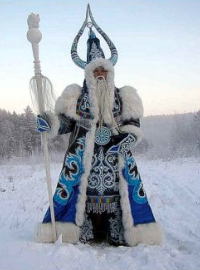
A modern interpretation of Ded Moroz.
All of them came to be representatives of the dark, cold winter period and thus were invariably depicted with heavy winter coats, a fur cap and a long beard, and with some suggestion in the native language of the English translation to “Father Winter.”
In Finland, it was Joulupukki. In Eastern European lands he was called Mikulás. Turkey had Noel Baba. Wales associated the King Arthur character Gwalchmei as part of the winter festivities.
In Russia, the character personifying winter, “Ded Moroz,” is traced back to before Christianity but this isn’t surprising since there was then no scientific grasp of the earth’s cycles and this seemingly omnipotent power of Nature was best understood in pagan mythology as a personification, used to explain the onset of bitter cold and the end of the harvest.
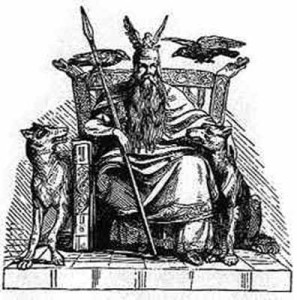
Odin.
The father of them all is believed to be the Norse god Odin. In the year of 98, in his book Germania about the northern tribes who lived outside the Roman Empire, the Roman historian Publius Cornelius Tacitus set down the first record referencing the ancient myth of Odin.
This suggests that Odin had existed in the imagination of northern pagans for likely several centuries in the B.C. era.
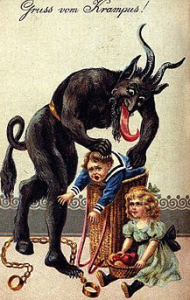
Krampus.
Thus, this primitive version of the fictional Santa Claus is certainly at least as old, if not older than the human Jesus Christ.
Certainly, he existed in the imagination of people before Christianity was well-established throughout Europe.
Other characters associated with Father Winter were also part of different mythological cultures, from the baby “Christkind” who distributed gifts, to “Badalisk,” an ugly Swiss creature with horns and a fiery mouth, to demonic “Krampus” who beat bad children.

Bad little Caganar.
There is even, in some regional Spanish sub-cultures, an ugly and even “Caganer” a little peasant boy who literally poops in the Nativity scene, though at a respectable distance from the Christ child.

20th century depictions of ancient Icelandic sprites.
Some winter mythologies included a young “snow maiden,” who was an assistant to Father Winter.
In Russian tradition, this maiden was Ded Moroz’s granddaughter and assigned the name of “Snegurochka.”
After the story of the birth of Christ became firmly established and disseminated around the world, other winter-related pre-Christian characters developed more fully, such as the “kobold,” who evolved from the mythological alpine figure “Knecht Ruprecht” or the myth of Icelandic sprites – or both. They are the forefathers of the North Pole’s Elves.

An 1853 photograph is the earliest known of a snowman.
“Frosty the Snowman,” first introduced into the American popular culture in 1950, was even derived from an earlier reference, the first known concept of a snowman being a drawing made in the margins of the 1380 medieval work Book of Hours.
More modern folklore are at the roots of the holiday character “Rudolph, the Red-Nosed Reindeer,” the “ninth” of Santa’s deers. It was a concept built upon the 1823 declaration of the “eight tiny rein-deer” first concocted by Clement C. Moore in his legendary The Night Before Christmas.

Frosty, Rudolph and the Elves are all based on earlier incarnations.
Certainly, the central importance of Christmas Eve and Christmas Day is the baby Jesus and there is no fictional substitution.
Still, the importance to the collective memories of earlier mythological figures now familiar as Santa Claus, Rudolph the Red-Nosed Reindeer, Frosty the Snowman and the North Pole Elves make them intractable figures forever associated with, and symbolic of the festive winter season of modern life.
“The Happy Holiday Season”

In the 1990s, the argument was mounted in the media that there was a “war on Christmas” by the alleged spike in the usage of the expression “Happy Holidays” instead of “Merry Christmas.”
If this was truly war, then the fighting had begun over a century and a half ago.
And during those seventeen decades there had been no menacing bells being rung to warn civilization that Christmas would soon be done asunder.
The first record of the term that would come to be known as “Merry Christmas” is from 1038 Old English word “Crīstesmæsse.” Yet, in the United States, the term “happy holidays” was already in print some three decades before Christmas Day became a federal holiday, in 1870.
Perhaps the earliest reference to “happy holidays” is from the New York Daily-Tribune issue of December 25, 1843. In fact, it is the very first line of a poem called “The Christmas Holidays,” in the fourth column of page three. And, true to modern form, it was used in an advertisement for the store Burgess, Stringer & Co., at 222 Broadway:


By 1871, the use of “happy holidays” was referenced not commercially but as a friendly salutary expression of the season, use of it being found on a page three editorial titled “Christmas Time” by Edward D. Channing of the Holmes County [Ohio] Republican on December 28, 1871:
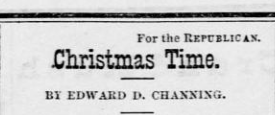
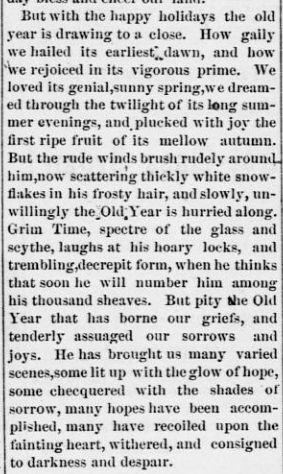
If strangers are simply slowing down their thoughts and deeds a bit to make an extra effort to think of others, to give a little bit to those who have nothing, or to share some time over a warm drink with loved ones as a refuge from the dark and cold, does it really matter what words they use to describe this time of the year?
Some will refuse to acknowledge how inextricably intertwined the facts of the celebration of the birth of Christ on Christmas Day are with the facts of the even earlier celebration of the onset of winter.
And there are those who will hear the familiar mantra of the season “Peace on earth and goodwill towards all men,” and wonder – what about the women?
Categories: Christmas
Tags: Christianity, Christmas, Jesus Christ, paganism, Santa Claus, Saturnalia, the Nativity
 The Santa Claus You Must Never See, If Yule Dare
The Santa Claus You Must Never See, If Yule Dare  President Claus: The Chief Executive as Santa
President Claus: The Chief Executive as Santa  Once Banned in Boston: Mince No Pie in the Old Bay State
Once Banned in Boston: Mince No Pie in the Old Bay State  Old Hollywood Movie Stars & their Holiday Greeting Cards
Old Hollywood Movie Stars & their Holiday Greeting Cards
Such an interesting read (as always). Thank you for putting it all into perspective and reminding us that winter celebrations are about light, warmth and love. Happy all the winter holidays to you!
Very nice… merry christmas to you and yours!